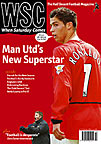 Once, twice and once more (as a coach) an Evertonian, Alan Harper had a host of nicknames and collected several medals for Mark Tallentire to count
Once, twice and once more (as a coach) an Evertonian, Alan Harper had a host of nicknames and collected several medals for Mark Tallentire to count
Alan Harper joined his team-mates in picking up the 1984 FA Cup while clad in an uncomfortably tight tracksuit top. It was almost as if he was underlining his bit-part status – Everton’s utility player had spent the final against Watford waiting patiently for the call which never came.
Harper, a natural right-back, arrived from Anfield in the summer of 1983 for £100,000, after Howard Kendall’s promise of involvement with the first team and a basic of £250 a week convinced him to make the switch. He hadn’t threatened to get among the low numbers at Liverpool, for whom he never played.
Round shouldered and glum of countenance, the 22-year-old defender known to Neville Southall as Bones did not look like an athlete and in the early days he did not play like one either, although by the time he left for Sheffield Wednesday in 1988 he had acquired cult status, a string of nicknames and a fistful of medals.
He first came to prominence in March 1984 when his sweet 30-yard shot flew past Bruce Grobbelaar to save a point late in a Goodison derby. The same month he won a League Cup runners-up medal after appearing for the injured Kevin Sheedy in the drawn Wembley final against Liverpool and playing the whole of the replay. His wholehearted if limited style soon won over fans, who dubbed him Mooncat because of a perceived likeness to a puppet on the children’s TV programme Get Up And Go, though on the quiet they remained broadly critical. “I have tremendous respect for him,” Kendall said at the time. “You need a player of his type in every squad.” The next season Everton had two of them, as Paul Bracewell signed in the summer and went straight into central midfield alongside Peter Reid, pushing Kevin Richardson down the pecking order and Harper’s nose even further out of joint.
That said, injuries and suspensions meant that he started ten games for the 1985 championship-winning team and came on three times. In the 1987 title season, by which time Richardson had moved on to Watford, he started 29 and came on in seven more, wearing six different numbers in all and scoring three of his five Everton goals. The best of them was a shot from distance at Chelsea to secure a crucial win during the championship run-in; so improbable was it that he earned another nickname that stuck, Zico.
Everton never lost a game in which he scored but the best remembered is his lob over the prone Martin Hodge to open the scoring in the 1986 FA Cup semi-final against Sheffield Wednesday, a game in which Everton had looked out of sorts without sidelined striker Gary Lineker. They got him back for the final and Harper did not make the bench, but ultimately he only missed out on a runners-up medal.
By the time he moved on in the summer of 1988 he had two championship medals, one from the FA Cup and another from the European Cup-Winners Cup in which, surprise, surprise, he was a non-playing substitute. He also played in four Charity Shields.
That was not that where Everton or Kendall were concerned, however, and after the former Goodison manager signed Harper for Manchester City from Wednesday he left Maine Road to begin a second spell in charge of the Merseyside club. Back he went for Harper, by now valued at £300,000, who he signed for a third time, although by then Mooncat had more to his game and played more of them than he sat out, in midfield, as sweeper or in defence, 34 in a row at one point. He’s now back at Everton as Under-19 coach – the utility man still has his uses.
From WSC 200 October 2003. What was happening this month